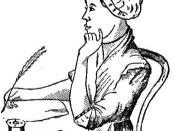Phillis Wheatley was existing in an era in which her very voice can not be heard, and the sight of her people was best viewed in the fields. The choices of one's expression
was extremely limited, and the essence of what a person was about was nullified by the harsh conditions of the present day culture. Given the circumstances, the black population were
not allowed to speak other than obeying a command, and this brought about great silencing of an entire culture. Being as suppressed as they were, no one could break free of the way of
life they were forced into, and therefore had to create their own unique ways of expressing what they believed in. This poem by Phillis Wheatley consummates that exact feeling of suppression
tied in with the hopelessness of the current era. By the end of this essay, it should be clear to the reader that Phillis Wheatley had very unique ideas in mind, and was not afraid to expose them
to have her voice be heard.
The greatest challenge that Phillis Wheatley had to confront is the suppressive forces that kept them silent.How could one create such a work of art and have an entire collection of
people relate to the message conveyed in this poem? First, that took courage. Secondly, it took a desire to express the very feelings they had within themselves that could directly sum up what
expectations they had of the afterlife,and of their mortal existence. Phillis Wheatley had a distinct vision, and it is directly conveyed in the following lines:
And may the charms of each seraphic theme
Conduct thy footsteps to immortal fame!
High to the blissful wonders of the skies
Elate thy soul, and raise thy wishful eyes
The message here is clear. They seem to...


